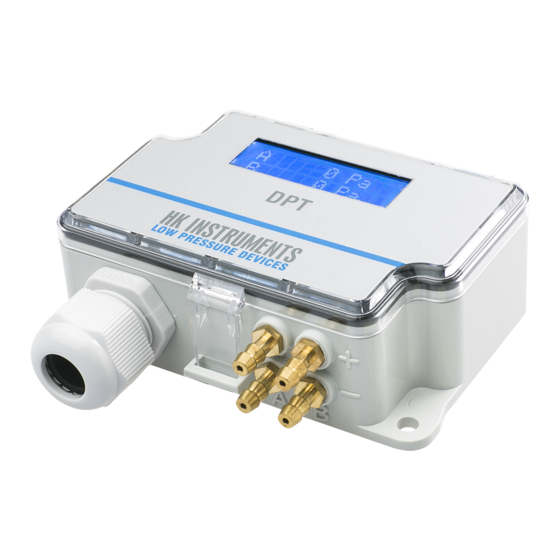
Advertisement
Quick Links
INTRODUCTION
Thank you for choosing an HK Instruments DPT series differential
pressure transmitter. The DPT series is intended for use in commer-
cial environments. It is designed with six unit selections (Pa, kPa,
mbar, inchWC, mmWC, psi) and eight field selectable measurement
ranges (unidirectional and bi-directional) to meet your application
requirements. The DPT-R8 series is comprised of the DPT250-R8
with ranges from 25 Pa to 250 Pa, the DPT2500-R8 with ranges
from 100 Pa to 2500 Pa, and the DPT7000-R8 with ranges from
1000 Pa to 7000 Pa.
All DPT-R8 series differential pressure transmitters are available
with display and autozero calibration.
APPLICATIONS
DPT-R8 series devices are commonly used in HVAC/R systems for:
• fan, blower and filter monitoring
• pressure and flow monitoring
SPECIFICATIONS
• valve and damper control
• pressure monitoring in cleanrooms
SPECIFICATIONS
Performance
Accuracy (from applied pressure):
Models 250 and 2500:
Pressure < 125 Pa = 1 % + ±2 Pa
Pressure > 125 Pa = 1 % + ±1 Pa
Model 7000:
Pressure < 125 Pa = 1.5 % + ±2 Pa
Pressure > 125 Pa = 1.5 % + ±1 Pa
(including: general accuracy, linearity, hysteresis, long
term stability, and repetition error)
Thermal effects:
Temperature compensated 0...50 °C
Overpressure:
Proof pressure: 25 kPa
Burst pressure: 30 kPa
Zero point calibration:
Automatic autozero or manual pushbutton
Response time:
8.0 s or 0.8 s, selectable via jumper
Technical Specifications
Media compatibility:
Dry air or non-aggressive gases
Measuring units:
Pa, kPa, mbar, inchWC, mmWC, psi, selectable via
jumper
Measuring element:
MEMS, no flow-through
Copyright HK Instruments 2018
DIFFERENTIAL PRESSURE TRANSMITTERS
DPT-R8 Series
• READ THESE INSTRUCTIONS CAREFULLY BEFORE
• Failure to observe safety information and comply with
• To avoid electrical shock or damage to equipment, disconnect
• To avoid potential fire and/or explosion do not use in potentially
• Retain these instructions for future reference.
• This product, when installed, will be part of an engineered
Environment:
Operating temperature: -20...50 °C,
-40C model: -40...50 °C
AZ-model: -20...50 °C,
Models with autozero calibration: -5...50 °C
Storage temperature: -40...70 °C,
-40C model: -40...70 °C
Humidity: 0 to 95 % rH, non condensing
Physical
Dimensions:
Case: 90.0 x 95.0 x 36.0 mm
Weight:
150 g
Mounting:
2 each 4.3 mm screw holes, one slotted
Materials:
Case: ABS
Lid: PC
Duct connectors: ABS
Tubing: PVC
Protection standard:
IP54
Display (Optional)
2-line display (12 characters/line)
Line 1: active measurement
Line 2: units
Electrical connections:
4-screw terminal block
Wire: 0.2–1.5 mm
(12–24 AWG)
2
Cable entry: M16
Pressure fittings:
Male ø 5,0 mm and 6,3 mm
www.hkinstruments.fi
WARNING
ATTEMPTING TO INSTALL, OPERATE OR SERVICE THIS
DEVICE.
instructions can result in PERSONAL INJURY, DEATH AND/OR
PROPERTY DAMAGE.
power before installing or servicing and use only wiring with
insulation rated for full device operating voltage.
flammable or explosive atmospheres.
system whose specifications and performance characteristics
are not designed or controlled by HK Instruments. Review
applications and national and local codes to assure that the
installation will be functional and safe. Use only experienced and
knowledgeable technicians to install this device.
+ High pressure
− Low pressure
Electrical
Voltage:
Circuit: 3-wire (V Out, 24 V, GND)
Input: 24 VAC or VDC, ±10 %
Output: 0–10V
Power consumption: <1.0 W,
-40C model: <4.0 W when <0 °C
Resistance minimum: 1 kΩ
Current:
Circuit: 3-wire (mA Out, 24 V, GND)
Input: 24 VAC or VDC, ±10 %
Output: 4–20 mA
Power consumption: <1.2 W,
-40C model: <4.2 W when <0 °C
Maximum load: 500 Ω
Minimum load: 20 Ω
Conformance
Meets the requirements for CE marking:
EMC Directive 2014/30/EU
RoHS Directive 2011/65/EU
WEEE Directive 2012/19/EU
COMPANY WITH
MANAGEMENT SYSTEM
CERTIFIED BY DNV GL
= ISO 9001 = ISO 14001 =
INSTALLATION
INSTRUCTIONS
RoHS 2
2011/65/EU
Installation version 6.0 2018
Advertisement

Subscribe to Our Youtube Channel
Summary of Contents for HK Instruments DPT Series
- Page 1 Line 2: units Measuring element: Electrical connections: MEMS, no flow-through COMPANY WITH 4-screw terminal block MANAGEMENT SYSTEM Wire: 0.2–1.5 mm (12–24 AWG) CERTIFIED BY DNV GL RoHS 2 Cable entry: M16 2011/65/EU = ISO 9001 = ISO 14001 = Pressure fittings: Male ø 5,0 mm and 6,3 mm Copyright HK Instruments 2018 www.hkinstruments.fi Installation version 6.0 2018...
- Page 2 24 VDC / 24 VAC 1) Mount the device in the desired location (see step 1). 2) Open the lid and route the cable through the strain relief and connect the wires to the terminal block(s) (see step 2). Figure 2b - Wiring diagram 4–20 mA output 3) The device is now ready for configuration. 0–10 V WARNING! Apply power only after the device is properly wired. 4–20 mA 24 V + Power supply 24 VDC / 24 VAC Copyright HK Instruments 2018 www.hkinstruments.fi Installation version 6.0 2018...
- Page 3 0–25.0 0–30.0 0–40.0 0–50.0 0–70.0 inchWC 0–4.00 0–6.00 0–8.00 0–10.0 0–12.00 0–16.00 0–20.00 0–28.00 mmWC 0–102.0 0–153.0 0–204.0 0–255.0 0–306.0 0–408.0 0–510.0 0–714.0 0–0.1450 0–0.21725 0–0.2900 0–0.3625 0–0.4350 0–0.5800 0–0.7250 0–1.0150 Copyright HK Instruments 2018 www.hkinstruments.fi Installation version 6.0 2018...
- Page 4 Under no circumstance is the seller liable for damages performing initial or periodic transmitter zero point calibration. The compensation for indirect damage. autozero adjustment takes 4 seconds after which the device returns to its normal measuring mode. During the 4 second adjustment period, the output and display values will freeze to the latest measured value. Transmitters equipped with the autozero calibration are virtually maintenance free. Copyright HK Instruments 2018 www.hkinstruments.fi Installation version 6.0 2018...















Need help?
Do you have a question about the DPT Series and is the answer not in the manual?
Questions and answers